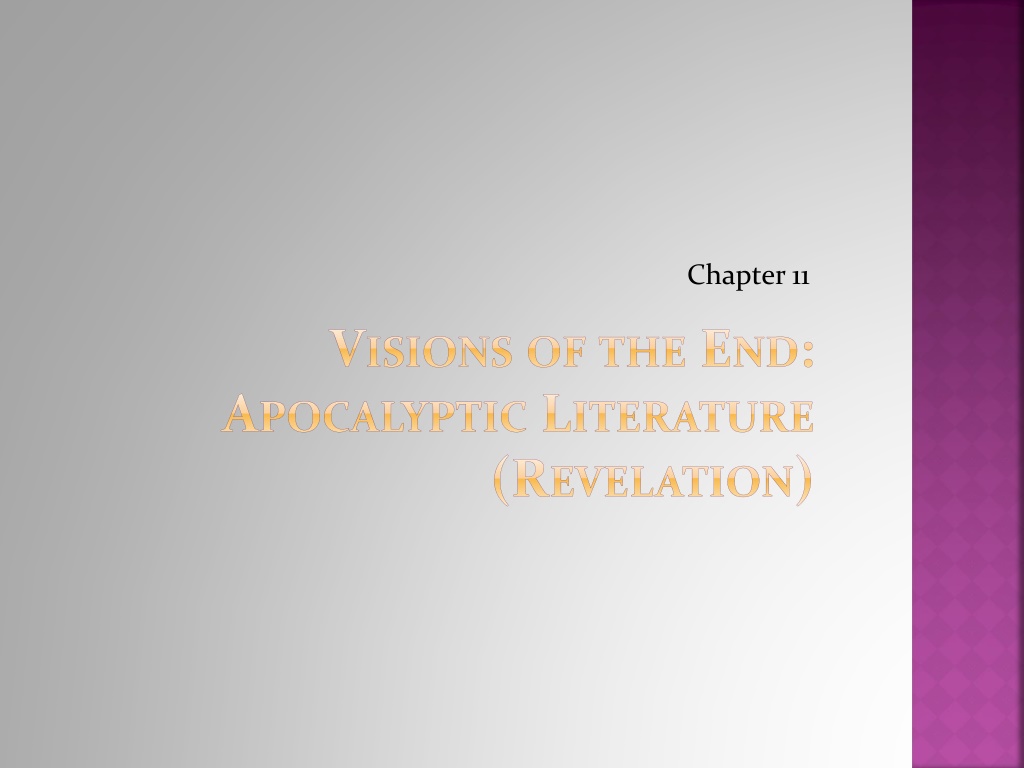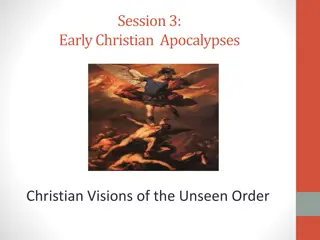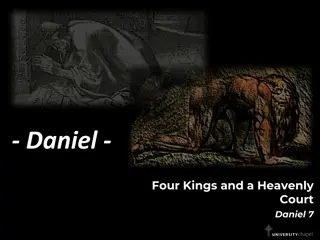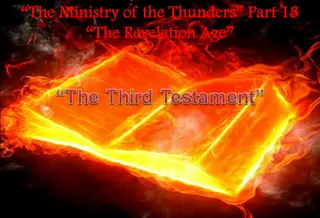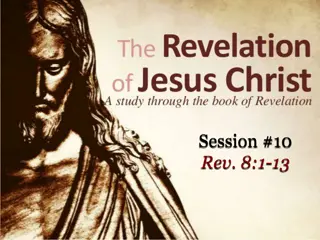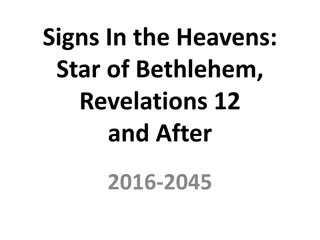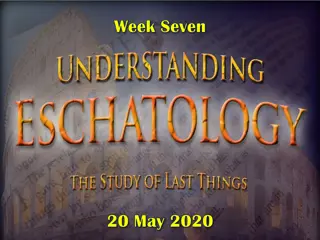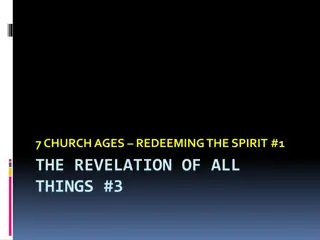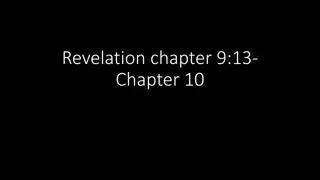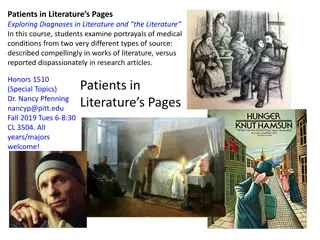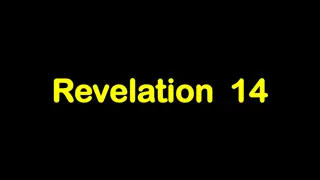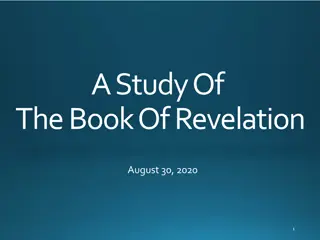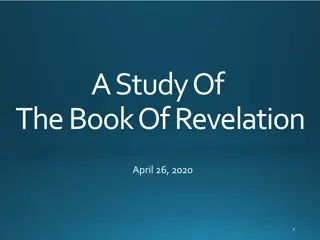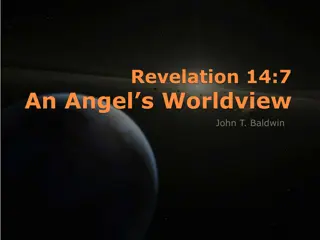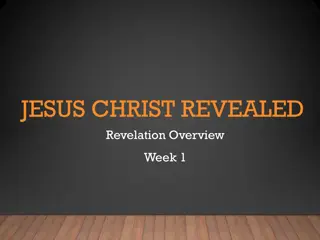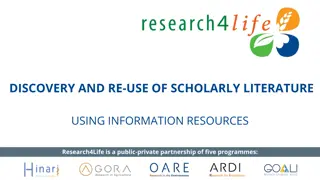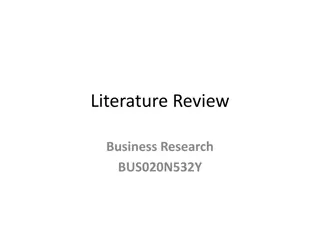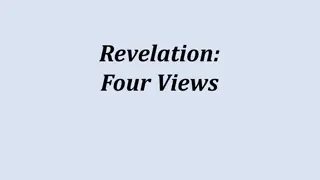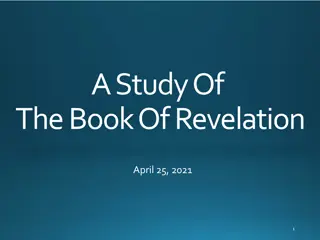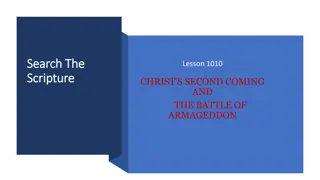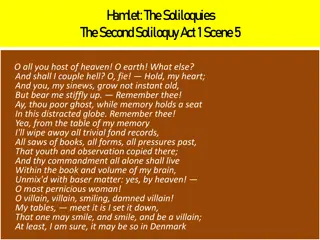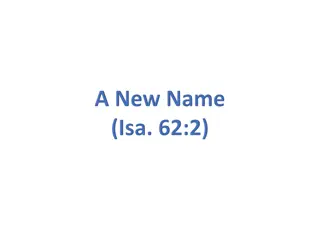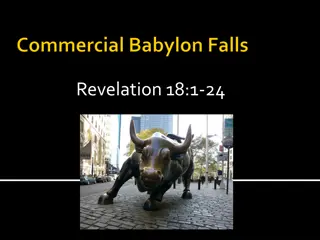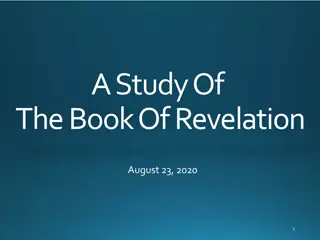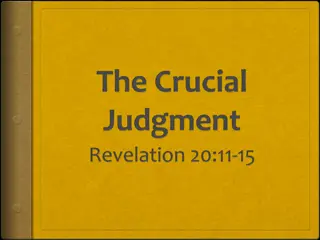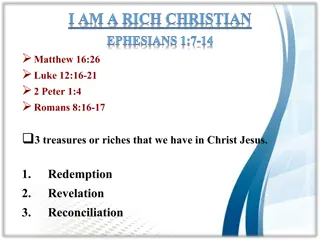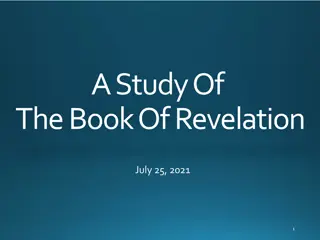Understanding Apocalyptic Literature in Revelation
Explore the fascinating genre of apocalyptic literature through an in-depth study of the Book of Revelation. Delve into the historical background, interpretative approaches, and essential elements of this profound genre that envisions the end times. Discover how apocalypticism merges earthly circumstances with supernatural realms to influence beliefs and behaviors. Uncover major interpretative approaches such as preterist and historicist perspectives that offer varying insights into the prophetic visions of Revelation.
Download Presentation

Please find below an Image/Link to download the presentation.
The content on the website is provided AS IS for your information and personal use only. It may not be sold, licensed, or shared on other websites without obtaining consent from the author. Download presentation by click this link. If you encounter any issues during the download, it is possible that the publisher has removed the file from their server.
E N D
Presentation Transcript
Chapter 11 VISIONS OF THE END: APOCALYPTIC LITERATURE (REVELATION)
CHAPTER OUTLINE Introduction and Definition of Apocalyptic Major Interpretative Approaches for the Study of the Book of Revelation Historical Background Literary Aspects Sample Exegesis: Revelation 11:1 13 Guidelines for Interpreting Apocalyptic Literature
INTRODUCTION AND DEFINITION OF APOCALYPTIC Definition of Apocalyptic Apocalypse Refers to a particular genre of literature written between approximately 200 B.C. and A.D. 200. Apocalyptic Describes either the literary genre or the worldview Apocalypticism Denotes a worldview, ideology, or theology merging the eschatological aims of particular groups into a cosmic and political arena.
INTRODUCTION AND DEFINITION OF APOCALYPTIC Definition of Apocalyptic John J. Collins: Apocalypse is a genre of revelatory literature with a narrative framework, in which a revelation is mediated by an otherworldly being to a human recipient, disclosing a transcendent reality which is both temporal, insofar as it envisages eschatological salvation, and spatial, insofar as it involves another, supernatural world. Collins, Hellholm, and Aune added: . . . intended to interpret present, earthly circumstances in light of the supernatural world and of the future, and to influence the understanding and behavior of the audience by means of divine authority.
INTRODUCTION AND DEFINITION OF APOCALYPTIC Definition of Apocalyptic Essential elements: comprises a visionary or revelatory means of communication; saturated with symbolic, figurative, and metaphorical language; the dualism between earthly and heavenly realities, usually steeped in eschatological significance.
MAJOR INTERPRETATIVE APPROACHES FOR THE STUDY OF THE BOOK OF REVELATION Preterist The preterist position approaches the relationship of history and the Apocalypse from the vantage point that the events prophesied were fulfilled in the first century. Historicist The historicists viewed John s vision as forecasting the course of history in Western Europe with particular emphasis on popes, kings, and wars. One may detect modern variations in readings of Revelation as if it were being fulfilled through current events on the world s stage.
MAJOR INTERPRETATIVE APPROACHES FOR THE STUDY OF THE BOOK OF REVELATION Idealist The idealist, timeless, or symbolic approach sets aside the historical question altogether by positing that Revelation is not about events in the space- time continuum but rather symbolically portrays the spiritual and timeless nature of the battle between good and evil. Futurist The fourth major approach for interpreting Revelation contends that chapters 4 22 refer to future events. In modern times, the futurist position enjoys pride of place among most evangelical Christians.
HISTORICAL BACKGROUND Type of Persecution John indicates that he was on Patmos owing to persecution related to his Christian witness (1:9) and associates his suffering with what the believers in Asia Minor will experience (6:9; 12:17; 20:4). Conflict in Smyrna apparently arose from the Jewish community (2:9). The remaining visions either reflect or expect a time of intense persecution as believers engage in a spiritual battle with the forces of Satan (chaps. 12 13).
HISTORICAL BACKGROUND The Emperor Cult The cult s political purpose was to express just how grateful and loyal the provinces were to the emperor. From its inception, the emperor along with the goddess Roma was worshipped and honored for their benevolence toward the provinces. Participants actually worshipped the emperor as divine. The temple to Domitian in Ephesus represented the pinnacle of the imperial cult s popularity in Asia Minor during his reign.
HISTORICAL BACKGROUND The Emperor Cult The colossal statue of Domitian, between twenty- two and twenty-six feet tall, was not only awe- inspiring but an object of worship. Thus, the second beast (13:11 15) that erects an image of the first beast and mandates everyone to worship it may correspond to the high priest of Domitian s imperial cult in Ephesus. References to the imperial cult in the Apocalypse can are unmistakable. Allusions to it occur frequently in the latter half of the second vision (13:4, 15 16; 14:9 11; 15:2; 16:2; cf. 20:4).
HISTORICAL BACKGROUND The Nero Redivivus Myth Shortly after Nero committed suicide on June 9, A.D. 68, Roman historians recount how a belief emerged throughout the empire that Nero had not actually died but was going to return with the Parthian army (Suetonius, Nero 49.3). The Nero redivivus myth surfaced in several apocalyptic Jewish and Christian writings toward the end of the first century. Two views emerged concerning Nero s return: One stems from the idea that Nero never died and that he was going to return with the Parthian army to conquer Rome. The other envisions a demonically empowered Nero-like figure that will attack God s people.
HISTORICAL BACKGROUND The Nero Redivivus Myth Revelation 13 describes how the dragon gives rise to the beast and endows him with authority. In Revelation 13:3, one of the beast s heads receives a fatal head wound but is miraculously resuscitated. As a result, the entire world worships him as he proceeds to slaughter faithful Christians (13:4 10). Although Nero is not mentioned by name, the language in Revelation13:1 7 suggests that John may have adapted the form of the Nero myth that alludes to the enemy of God s people in Daniel 7:2 25.
HISTORICAL BACKGROUND The Nero Redivivus Myth In addition, Revelation 17:10 12 reflects parallels with the other form of the Nero redux myth depicting Nero s attack on Rome. John s portrayal differs radically from the other expectations of Nero s return, because in the Apocalypse the beast actually rises from the dead (redivivus), whereas all the other examples assume Nero never died (redux). The reason John departs from the usual tradition is that in his vision the beast mimics Christ who died and rose again and will return to conquer the world s kingdoms.
LITERARY ASPECTS General Literary Features Genre Prophetic-apocalyptic Setting Historical setting Visionary setting John used the phrase in the Spirit to indicate the means of his vision, and this phrase occurs four times to signal a new vision (1:9; 4:2; 17:3; 21:10).
LITERARY ASPECTS General Literary Features Narrative Framework The book has a clearly delineated prologue (1:1 8) and epilogue (22:6 21). It is divided into four visions marked by the phrase in the Spirit (1:9; 4:2; 17:3; 21:10). Several series of sevens pervade the book (2:1 3:22; 6:1 8:1; 8:2 11:19; 15:1 16:21). In a tale of two cities, the harlot city of Babylon (chaps. 17 18) is contrasted with the bride city of the New Jerusalem (chaps. 21 22).
LITERARY ASPECTS General Literary Features Characterization At the heart of the characterization of the book is the Lord Jesus Christ who is presented as risen and glorious, as the source of revelation regarding the state of the seven churches (chaps. 1 3) as well as regarding the final judgment (chaps. 4 18), and as the one who returns triumphantly at the end of time to establish his kingdom (chaps. 19 22). John also features prominently in the book as the author and narrator. Angels, both elect and evil, appear as significant characters throughout the book. The believers in the seven churches.
LITERARY ASPECTS General Literary Features Minor Transition Markers Minor visionary transitions within any one of the four visions featured in the book are often signaled by references to seeing or hearing. Series of Sevens and Relationship between the Sevens Within these series of sevens, schemes vary from six, seven, and eight septets. The nature of the relationship between the seven seals, trumpets, and bowls has long confounded interpreters. There are three primary theories: (1) chronological succession; (2) recapitulation; and (3) telescopic progression.
LITERARY ASPECTS General Literary Features Interludes The first two emerge between the breaking of the sixth and seventh seals (7:1 17) and between the blowing of the sixth and seventh trumpets (10:1 11:14). They are bound to the preceding sections and provide answers for questions that the audience might be asking. The third interlude differs from the first two in that it occurs at the end of the seventh trumpet and precedes the introduction of the seven bowls.
LITERARY ASPECTS Special Literary Features Assessing and Interpreting Old Testament Allusions Three problems There is persistent confusion over terminology, including what appears to be confusion over echo, allusion and quotation or citation. The audience-oriented or reader-response approach to the use of the Old Testament. What is intended by such analyses of the use of the Old Testament. Intertextuality Allusion Echo
LITERARY ASPECTS Special Literary Features Assessing and Interpreting Old Testament Allusions The almost continuous allusion to the Old Testament in the Book of Revelation is not a haphazard phenomenon but reflects a pattern of disciplined and deliberate allusion to specific Old Testament texts. A possible way forward is to propose a distinction between levels of authorially intended meaning. The distinction proposed is between the authorially intended meaning of the surface/primary text and the source/subtext. The interpreter of Revelation is ultimately concerned with what John intended the allusion to mean rather than with the original intent of the Old Testament writer. This is not a distinction in kind (pitting the texts against one other) but in degree (giving precedence to the new context).
LITERARY ASPECTS Special Literary Features Assessing and Interpreting Old Testament Allusions Before we will be able to answer the question of what is intended by the author s use of the Old Testament, we will need to develop criteria for identifying allusions: (1) embedded allusion; (2) implied allusion; and (3) incidental allusion. Embedded Implied Incidental Clear Probable Structural Thematic Typological Conceptual Loud Soft Allusion Allusion Allusion Allusion Allusion Allusion Eho Echo
LITERARY ASPECTS Special Literary Features Assessing and Interpreting Old Testament Allusions Criteria Linguistic parallels Lexical indicators Syntactical indicators Theological significance Contextual consistency Transitivity Availability Shared knowledge Exegetical tradition
LITERARY ASPECTS Special Literary Features Assessing and Interpreting Old Testament Allusions Seven categories of use Fulfillment of prophecy Analogical use Indirect OT typological prophecies Inverted or ironic use of the OT Use of OT themes Use of OT as a literary prototype or model Stylistic use of OT language
LITERARY ASPECTS Special Literary Features Types of Figurative Language By using analogical language, figures of speech lead the reader from the known to the unknown, in the present case, future events. Thus, their use helps alleviate the difficulty of communicating a subject the end times that defies mere propositional or descriptive language. The Symbolic Nature of Revelation It is undeniable that the Apocalypse contains a legion of symbolic and metaphorical images, but interpretive approaches divide sharply as to how these symbols should be interpreted: (1) primarily literal and secondarily symbolic; or (2) primarily symbolic and secondarily literal.
LITERARY ASPECTS Special Literary Features Interpreting Symbols in Revelation Recognize the symbolic imagery associated with the description of people and beings, colors, numbers, institutions, places, and events. Look for interpretations of those symbols within the vision.
SELF-INTERPRETED SYMBOLS IN REVELATION Reference Symbol Interpretive Signal Symbol Identified 1:20 seven stars [they] are the angels of the seven (eisin) churches 1:20 seven lampstands [they] are the seven churches (eisin) 4:5 seven lamps before the these are the seven spirits of God throne (ha eisin) 5:6 seven horns and seven which are the seven spirits of God eyes of the Lamb (hoi eisin) sent out into all the earth 5:8 golden bowls full of which are the prayers of the saints incense (hai eisin) 7:13 14 the multitude in white these are the saints who have come robes (houtoi eisin) out of the great tribulation
SELF-INTERPRETED SYMBOLS IN REVELATION Reference Symbol Interpretive Signal Symbol Identified 11:4 the two olive trees and these are the two witnesses the two lampstands that (houtoi eisin) stand before the Lord of the earth 14:4 the 144,000 these are those who did not defile (houtoi eisin) themselves with women and kept themselves pure 17:9 the seven heads of the [they] are seven hills (Rome) and beast (eisin) also seven kings (emperors?) 19:8 fine linen, bright and stands for the righteous acts of the clean (gar ... estin) saints
LITERARY ASPECTS Special Literary Features Interpreting Symbols in Revelation Determine if the symbol stems from an allusion to the Old Testament. Compare the symbol with other apocalyptic writings to see if it is a common symbol with a relatively standard meaning. Look for any possible connections between the symbol and the cultural-historical context. Consult treatments of the symbol in scholarly commentaries and other works. Remain humble in your conclusions.
LITERARY ASPECTS Structure Outline #1 Prologue (1:1 8) Vision One (Patmos): The Glorified Christ and His Message to the Churches (1:9 3:22) The Inaugural Vision of Jesus Christ (1:9 20) The Messages to the Seven Churches of Asia Minor (2:1 3:22)
LITERARY ASPECTS Structure Outline #1 Vision Two (Heaven): The Divine Court Proceedings and the Trial of the Nations (4:1 16:21) Transition from Patmos to Heaven (4:1 2) Worship around the Throne (4:3 11) The Divine Courtroom (5:1 14) Preliminary Investigative Judgments (6:1 17) First Interlude: The Protective Sealing of God s People (7:1 17) Eschatological Investigative Judgments (8:1 9:21) Second Interlude: God s People as Prophetic Witnesses (10:1 11:19) Third Interlude: The Signs Narrative/God s People in Holy War (12:1 15:1) Final Investigative Judgments: The Third Woe/Seven Bowls (16:1 21)
LITERARY ASPECTS Structure Outline #1 Vision Three (Desert): The Destruction of Babylon and the Return of Christ (17:1 21:8) Transition: Come, I Will Show You the Punishment of the Great Prostitute (17:1 2) The Prostitute City Babylon Described (17:3 6) The Prostitute City Babylon as Rome (17:7 18) The Trial and Sentencing of Babylon (18:1 24) The Heavenly Celebration of Babylon s Destruction (19:1 10) The Divine Warrior and the Final Tribunal (19:11 20:15) The Renewal of Creation and the Arrival of the New Jerusalem (21:1 8)
LITERARY ASPECTS Structure Outline #1 Vision Four (Mountain): Believers Reward and the Renewal of Creation (21:9 22:5) Transition: Come, I Will Show You the Bride (21:9 10) The Description of the New Jerusalem Descending from Heaven (21:11 27) The Paradise of God: The Renewal of Creation (22:1 5) Epilogue (22:6 21)
LITERARY ASPECTS Structure Outline #2 Prologue: Opening Remarks and Doxology (1:1 8) The Seven Letter Scroll (1:9 3:22) Preparation: Christ among the Seven Churches (1:9 20) Letters to the Seven Churches (2:1 3:22) The Heavenly Scroll (4:1 22:5) Preparation: Heavenly Worship (4:1 11) The Seven Seals Opened (5:1 8:1) The Seven Trumpets: Heralding the Opening of the Scroll (12:1 22:5) Epilogue: Closing Remarks and Benediction (22:6 21)
SAMPLE EXEGESIS: REVELATION 11:1 13 History Literature Theology
GUIDELINES FOR INTERPRETING APOCALYPTIC LITERATURE Locate the historical setting of the Book of Revelation. Distinguish between intertextuality, inner- biblical exegesis, allusion, and echo. Identify the type of allusion, whether embedded, implied, or incidental. Identify the specific Old Testament passage(s) invoked in a given passage in Revelation. Identify the plot and development of the Book of Revelation and relate the specific passage to the overall plot. 1. 2. 3. 4. 5.
GUIDELINES FOR INTERPRETING APOCALYPTIC LITERATURE Identify the major characters and their role in the narrative. Identify the major theological themes in the Book of Revelation. Identify the way in which a given theological theme finds its culmination in Revelation. Determine principles for godly living in view of the culmination of Christ s kingdom at his return. 6. 7. 8. 9.
